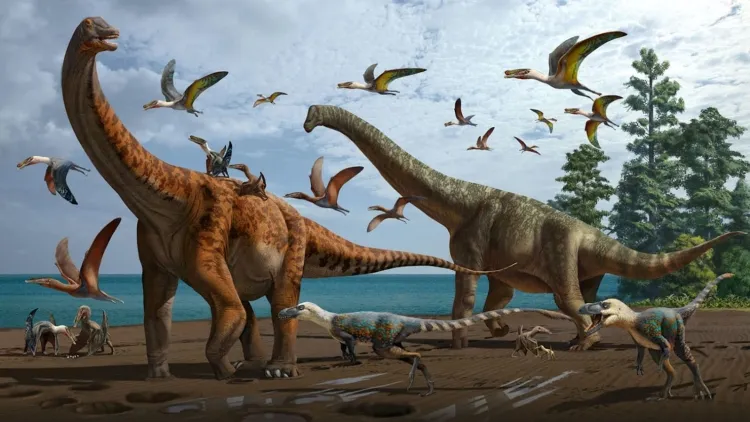Dinosaurs: A Fascinating Legacy of the Mesozoic Era...!!!
Dinosaurs were a diverse and dominant group of animals that ruled the Earth for millions of years.

Dinosaurs, among the most intriguing creatures to have ever inhabited the Earth, lived during the Mesozoic Era, which spanned approximately 180 million years from around 252 to 66 million years ago. This era is divided into three periods: the Triassic, Jurassic, and Cretaceous. Dinosaurs exhibited incredible diversity, with thousands of species differing in size, shape, and behavior.
Origins and Evolution
Dinosaurs first emerged during the late Triassic period, around 230 million years ago. They evolved from a group of reptiles known as archosaurs. Initially, these early dinosaurs were small, bipedal predators, but they quickly diversified and adapted to various ecological roles. Dinosaurs began to dominate during the Jurassic period, following the Triassic-Jurassic extinction event, which eliminated many competing reptile groups.
Types of Dinosaurs
Dinosaurs can be broadly classified into two major groups based on their hip structure: Saurischia and Ornithischia.
Saurischia (Lizard-Hipped Dinosaurs)
This group includes theropods and sauropodomorphs.
-
Theropods: Primarily carnivorous, these dinosaurs walked on two legs and include famous species such as Tyrannosaurus rex, Velociraptor, and Allosaurus. Some theropods are ancestors of modern birds, as evidenced by shared anatomical features.
-
Sauropodomorphs: These were mainly herbivorous and included the giant, long-necked dinosaurs like Brachiosaurus, Diplodocus, and Apatosaurus. They walked on four legs and were some of the largest animals to have ever existed.
Ornithischia (Bird-Hipped Dinosaurs)
This group is entirely herbivorous and comprises dinosaurs with a variety of body shapes and sizes.
-
Examples: Stegosaurus, with its distinctive back plates; Triceratops, known for its three horns and frilled neck; and Hadrosaurs, or duck-billed dinosaurs, which had complex teeth adapted for grinding plant material.

Behavior and Adaptations
Dinosaurs displayed a wide range of behaviors and adaptations that allowed them to thrive in different environments. Some were solitary hunters, while others lived in herds for protection against predators. Evidence from fossilized nests and eggs indicates that many dinosaurs, such as Maiasaura, cared for their young.
Adaptations varied widely among species. For example, the long necks of sauropods enabled them to reach high vegetation, while the sharp claws and teeth of theropods made them effective predators. Some dinosaurs, like Ankylosaurus, had armored bodies and club-like tails for defense.
Fossil Discoveries
Fossils are the primary evidence of dinosaur existence. These remains, preserved in sedimentary rock, include bones, teeth, footprints, and even skin impressions. Paleontologists study these fossils to understand dinosaur anatomy, behavior, and evolution. Renowned fossil sites include the Morrison Formation in the United States, the Gobi Desert in Mongolia, and the Badlands of Canada.
Extinction
Dinosaurs, except for the avian lineage that led to modern birds, went extinct around 66 million years ago at the end of the Cretaceous period. This mass extinction event is widely believed to have been caused by a combination of factors, including a massive asteroid impact and volcanic activity. The impact would have triggered environmental changes, such as wildfires, acid rain, and a "nuclear winter" effect, blocking sunlight and disrupting ecosystems.
Dinosaurs and Birds
Modern birds are considered the direct descendants of theropod dinosaurs. This connection is supported by numerous similarities in skeletal structures, nesting behaviors, and even the presence of feathers in some dinosaur fossils. Discoveries of feathered dinosaurs, such as Archaeopteryx and Velociraptor, provide critical evidence of this evolutionary link.
Cultural Impact
Dinosaurs have captured the imagination of people worldwide and have become a prominent part of popular culture. From movies like "Jurassic Park" to educational exhibits in museums, dinosaurs continue to fascinate and educate. Their majestic sizes, fearsome appearances, and the mystery of their extinction contribute to their enduring appeal.
Dinosaurs were a diverse and dominant group of animals that ruled the Earth for millions of years. Through fossil discoveries and scientific research, we continue to uncover the secrets of their lives, behaviors, and ultimate demise. Their legacy lives on not only in the form of modern birds but also in the lasting fascination they inspire in people of all ages.
What's Your Reaction?

















